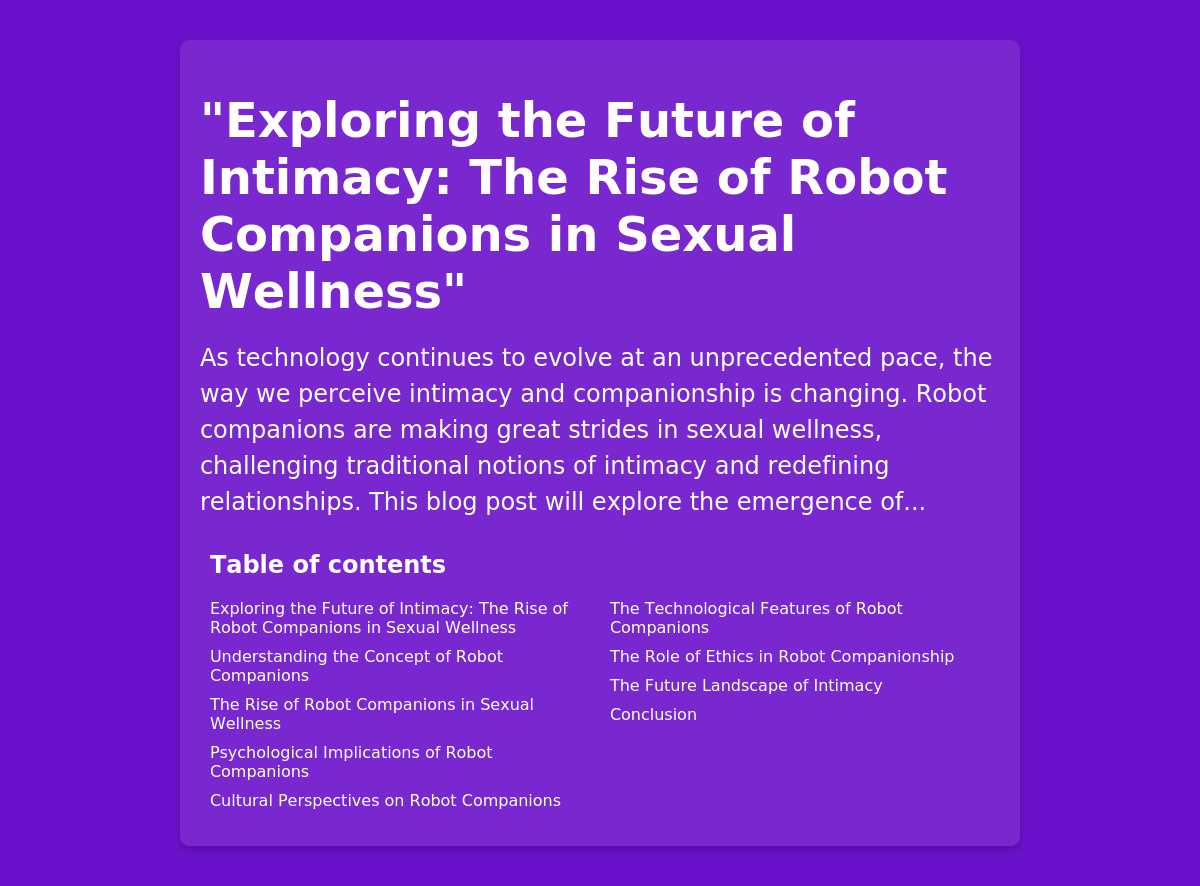Exploring the Future of Intimacy: The Rise of Robot Companions in Sexual Wellness
Exploring the Future of Intimacy: The Rise of Robot Companions in Sexual Wellness
As technology continues to evolve at an unprecedented pace, the way we perceive intimacy and companionship is changing. Robot companions are making great strides in sexual wellness, challenging traditional notions of intimacy and redefining relationships. This blog post will explore the emergence of robot companions in the realm of sexual wellness, the psychological implications of such partnerships, and the future landscape of intimacy marked by technological advancement.
Understanding the Concept of Robot Companions
What Are Robot Companions?
Robot companions, sometimes referred to as sex robots or relationship robots, are designed to provide companionship and engage in intimate activities with humans. These robots can range from simple dolls equipped with basic artificial intelligence (AI) to sophisticated humanoid robots capable of learning and adapting to the preferences of their users.
Types of Robot Companions
| Type | Description | Example |
|---|---|---|
| Basic Dolls | Non-interactive, designed primarily for physical use | RealDoll |
| AI-enhanced Dolls | Dolls with basic AI capabilities for conversation | LuvBot |
| Humanoid Robots | Advanced robots that can hold realistic conversations and exhibit human-like behavior | Harmony |
| VR Companions | Virtual reality experiences providing immersive interactions | Virtual Reality Attractions |
The Rise of Robot Companions in Sexual Wellness
Historical Context
Dating back to ancient civilizations, the innately human desire for companionship can be traced throughout history. From early erotic objects to modern-day sex toys, the evolution of intimacy has always incorporated technological advances. With the advent of robotics and AI, this evolution has now entered a new phase.
The Modern Development of Robot Companions
In the last decade, advancements in AI and robotics have fueled the development of high-tech companions. Researchers and manufacturers are now focusing on creating robots that aren’t merely objects but entities capable of conversation and emotional engagement. It marks a significant shift towards seeing robots as fulfilling emotional needs rather than just physical desires.
Psychological Implications of Robot Companions
Understanding Human Attachment to Robots
The psychology of attachment is a well-studied field, and its principles can apply to how humans interact with robot companions. Numerous studies suggest that people can form emotional attachments to robots, viewing them as confidants and companions.
Benefits of Robot Companions
-
Reduction of Loneliness: For many, robot companions can provide a much-needed sense of companionship, especially for individuals who struggle with loneliness or social anxiety.
-
Safe Exploration of Sexuality: Robot companions allow individuals to explore their sexuality in a safe environment without the fear of stigma or rejection.
-
Support for Mental Health: For those undergoing therapy or suffering from psychiatric challenges, robot companions can serve as a supplementary source of emotional support.
Concerns Surrounding Robot Companions
While the benefits are significant, there are concerns about the implications of forming attachments to robotic entities:
| Concern | Description |
|---|---|
| Dependency | Individuals may become overly reliant on robots for emotional needs, neglecting human relationships. |
| Ethical Considerations | Issues around consent, objectification, and the treatment of robots as humans arise. |
| Reality vs. Fantasy | The fine line between real-life relationships and artificial companionship may blur, affecting expectations in human interactions. |
Cultural Perspectives on Robot Companions
The Global Landscape of Acceptance
Robot companions are viewed differently across cultures. In some regions, they are embraced for promoting sexual wellness, while in others, they face resistance shaped by societal norms.
Comparative Cultural Analysis
| Region | Acceptance Level | Cultural Resistance | Potential Market Growth |
|---|---|---|---|
| North America | High | Concerns around ethics and relationships | Expanding rapidly |
| Europe | Moderate | Mixed views on sexuality and robotics | Steady growth |
| Asia | High | Attachments to technology and modern relationships | High potential in youth market |
| Middle East | Low | Strong cultural and religious resistance | Limited growth |
Representation in Media
The portrayal of robot companions in films, literature, and popular culture shapes societal perceptions. From cinematic depictions like “Her” to literature exploring ethical dilemmas, media has a profound impact on how people conceptualize robots in intimacy.
The Technological Features of Robot Companions
Advances in Artificial Intelligence
The incorporation of AI allows robot companions to learn user preferences, adapting their behaviors and responses accordingly. With advancements in natural language processing, conversations with robots are becoming increasingly realistic.
Sensory Technologies
Modern robots are equipped with sensory technologies that mimic human touch. These features enhance the experience of intimacy and provide a more fulfilling interaction.
Customization Options
Many robot companions offer customizable features, allowing users to tailor their experience based on personal preferences such as appearance, personality traits, and behavior. This personalization fosters a sense of familiarity and intimacy.
| Feature | Customization Options |
|---|---|
| Appearance | Skin tone, hair color, body type |
| Voice | Accent, tone, speech patterns |
| Personality Traits | Empathy level, humor, assertiveness |
The Role of Ethics in Robot Companionship
Ethical Guidelines and Practices
The rise of robot companions has led to discussions about ethical guidelines surrounding their design and usage. Important topics include:
- Consent: As robots become more lifelike, the importance of programming ethical frameworks becomes paramount.
- User Safety: Ensuring that robot companions do not reinforce harmful stereotypes.
- Transparency: Offering users a clear understanding of the capabilities and limitations of robot companions.
Future Ethical Considerations
As technology evolves, ethical considerations will need to keep pace. Philosophical questions will likely arise about the potential for robots to hold rights or the responsibilities of their creators towards ensuring positive interaction experiences.
The Future Landscape of Intimacy
Shifts in Relationship Norms
The integration of robot companions into daily life could lead to new norms in relationships, where humans establish connections with both biological individuals and robotic partners. This shift holds the potential to challenge existing societal structures and definitions around love and intimacy.
The Impact of Loneliness and Mental Health
The increasing prevalence of loneliness, particularly in urban areas and among younger generations, may drive further adoption of robot companions as a means to fulfill emotional needs. The relationship between mental health and the companionship provided by robots will continue to be an essential area for research.
Conclusion
The rise of robot companions in sexual wellness represents a significant transformation in the perception of intimacy and companionship. With the integration of cutting-edge technology, we stand on the cusp of a future where human relationships are enriched—or challenged—by the presence of robotics.
As we navigate this landscape, ethical considerations and further research will dictate how society adapts to these new forms of companionship. The potential benefits may be boundless, yet the implications on human connection and intimacy must be carefully examined and understood.
Final Thoughts
Robot companions are not merely technological novelties; they spark crucial conversations about intimacy, love, and human relationships in the digital age. How we shape the future of these relationships will depend on our understanding, acceptance, and ethical considerations as we continue to explore the intersection of technology and human emotion.
Share with PDF: Download












Leave a Reply